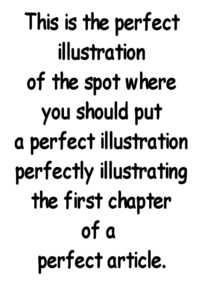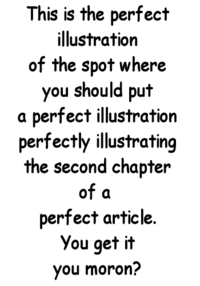A perfect article
“A perfect article has to begin with an Oscar Wilde quotation.”
– Oscar Wilde on the way he sees perfection
A perfect article has to begin by mentioning enough to intrigue the reader without saying too much, so it stays interesting. A good introduction uses no more than two sentences. Well, okay, let's say three sentences but this is it, unless of course the author decides to write more than one paragraph in the introduction of his article.
In that case, it's possible to use four sentences. Maybe even five, but only if there's something really interesting to tell. By the way, that reminds me of a story: One day I read a perfect article in which there were six sentences in the introduction; how funny was that!
The first chapter[edit | edit source]
Even if it's not as important as the introduction, the first chapter is essential. From its title the reader has to understand what it's going to be about. Sometimes I read so-called "perfect articles" where I found in the very first chapter some ideas that should rather be in the second or even maybe the third chapter. This is totally inconceivable when you talk about a perfect article. The idea of perfection implies that the first chapter should include only what belongs to the first chapter. No more, no less.
Nevertheless, the perfection of the first chapter is a necessary condition but it's not the only condition to get a perfect article. You can achieve perfection only if you include—beside the words—an illustration in total osmosis with the text. The positioning of the illustration is also of the utmost importance and you should consider it with great attention. How often have I seen text with a perfect balance totally tumble down due to an illustration being inserted in the wrong spot?
And I haven't even mentioned the illustration's caption yet! Don't fall into the classic trap of neglecting the caption below the illustration in the first chapter. Consider the perfect article as a jigsaw puzzle: each piece, even the smallest, has one and only one spot where it fits. The article can be called "perfect" only when all its pieces are in the right place.
A lot of people ask me: "What should be the length of the first chapter?" The answer is pretty simple. It depends on the length of the introduction. The first chapter must have exactly twice the numbers of paragraphs in the introduction. For example, if the introduction uses two paragraphs, then the first chapter has to be four paragraphs long. There is the mathematical formula used to recall this rule:
The second chapter[edit | edit source]
The creation of the second chapter is induced by the existence of the first chapter. Some would think this part is easy but more than often, the second chapter is much more difficult to write than the first one. Sometimes, the author, with his fingers flying over his keyboard like an unstoppable falcon over the forest, has already revealed so many new concepts in the first chapter that he doesn't know what the hell he's going to talk about in that motherfucking bitch of a second chapter.
Well, these kinds of excuses can't find their place in a perfect article. It's obvious: Perfection cannot be achieved by everyone. Genius is a rare resource; you won't find it in the bottom of your toilet (well, I hope not). In my life I've met a lot of pretentious authors looking for perfection, who tried to disguise their lack of literary skills by filling their articles with tons of useless and sometimes totally unintelligible sentences—and sometimes directly in the second chapter!
But you can't argue with perfection. When your goal is to write a perfect article you cannot make any compromise. Trying to be a genius and improvising is nonsensical. It's so easy to write tons of words and sentences about any subjects—like, for example, seafood. Seafood is not a topic you will find very often in a perfect article.
Is it necessary to illustrate the second chapter? It is an obligation by all means! Perfection is a synonym of harmony which is a synonym of peace which is a homophone of piss. And symmetry is one side of the harmony. So as long as you illustrate the first chapter, you must illustrate the second one. Concerning the length of the second chapter, it also has to be in phase with the length of the first one according to this formula:
The other specifics[edit | edit source]
The perfect article cannot be made up with only one introduction and two chapters. Like a famous recipe of a notorious French chef, some other ingredients which may seem to have only a decorative purpose to the eyes of the newbie have to be incorporated to obtain a flawless result. Among these ingredients, you will find what we could call the "other specifics" concerning the main subject of the article.
Some people ask me: "Is it possible to add some footnotes in a perfect article?"[1] or "Is there a risk they may interfere with the smoothness of the article?"[2] and sometimes "What is the maximum number of footnotes tolerated?"[3] Unfortunately there are no universal answers to these questions. This matter will be addressed in the very ending of this article.
At this point, it seems to be obligatory to talk about a very important subject, digression. A player is in an offside position if he is in his opponents' half of the field and is nearer to his opponents' goal line than the ball, and fewer than two of his opponents (which might include the goalkeeper) are in front of him. A player at equal distance from the goal line as the second to last opponent is not in an offside position.
The question of the importance you should give to these other specifics (footnotes, digression, and lists of items between parentheses) still divides the community of the perfect authors. In my humble opinion, the total length of these specifics should not exceed the length of a whole chapter. Otherwise it would leave the whole article unbalanced.
Conclusion[edit | edit source]
The concepts I explained in this article have to be learnt by heart. Each one represents a necessary condition to creating a perfect article. And please never forget the conclusion. It has to sum up the ideas that have been revealed all along the article but it still has to let the reader try to imagine what should come next. As a perfect writer, you should not act as if you always hold the Truth. Let the reader understand that you do.
It is important to remember that the conclusion will be the final piece of text for the reader's mind to integrate. It would be disastrous for a perfect article to get an unfavorable evaluation just because of a bad ending. It's generally the quality of the conclusion that makes the difference between ordinary writing and a masterpiece of perfection.




